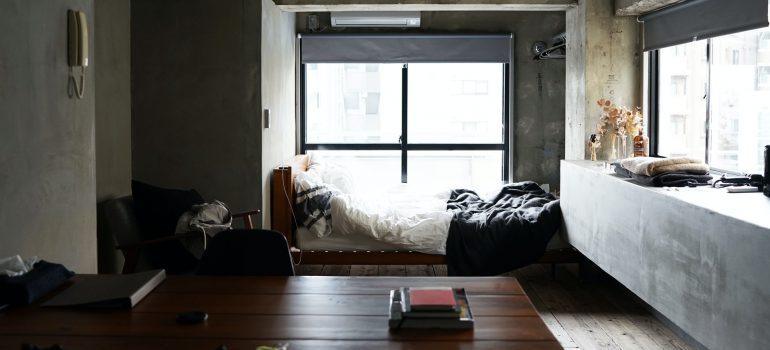For city lovers, it’s not rare to pay lots of money in rent for a few square feet. However, for those who are willing to gain a little less to spend a little less, there are good options. One of them might be a micro-apartment. Micro-apartments have been coming up over the past couple of years. In big cities like New York and Seattle, this kind of apartment provides renters with a more compact living space. However, while the price of renting looks appealing, you have to know what to expect before moving to a micro-apartment. In this article, we’ve gathered the details about micro-apartments. That includes what they are and what are the benefits and downsides od renting them. Also, we have the right tips for living in smaller spaces.
Before moving to a micro-apartment, get to know what a micro-apartment is
Let’s begin with the basics. A micro-apartment is a single occupant studio. It is designed to be as compact and practical as possible. You can expect to find all of the amenities that a traditional studio apartment has. Simply imagine bathroom, kitchen, and living space, all squeezed into about 200 to 400 square feet. Surely, you can suppose why moving to a micro-apartment is a task for the best interstate movers Raleigh NC. It is not easy to fit all your belongings into an apartment about the size of a one-car garage, right?

Moving to a micro-apartment gives you full use of the space
Generally, micro-apartments are designed to maximize the appearance and utility of the available square footage. With the use of design elements like high ceilings and tall windows, it can be successfully done. All of it brings in more height and airiness. Also, some smart features like Murphy beds and tables which fold into the wall when not in use help. Interstate movers also have many useful ideas on this matter. Also, micro-units are private. That’s why people who live there don’t have to worry about sharing essential spaces with roommates. However, there are additional communal spaces that help offset the small living environment. For instance, pools, gyms, or doormen. This is a part of alternative rental options in high-demand areas.
Pros and Cons of moving to a micro-apartment unit
To decide if a micro-unit is a good fit for you, you should start with a pro/con analysis. You would surely want to weigh both advantages and disadvantages before leaping.
Pros of relocating to a micro-apartment
- It is often cheaper to rent a micro-unit per month than a standard studio.
- Utility costs of a micro-apartment are lower than a standard studio, as well.
- It is cheaper to decorate and furnish a micro-apartment.
- Micro-apartments offer communal amenities, such as game rooms, laundry rooms, and on-site security.
- It is easier to maintain and keep it clean than a bigger apartment, for sure.
- No roommates can be an advantage of moving to a micro-apartment.
Micro-apartment cons
- Sometimes, it is not cheaper to rent a micro-apartment than average rent in the area.
- It offers minimal living space and storage.
- Pay attention to no-pet-policies or strict limits on pets.
- It isn’t family-friendly or fit to grow into, due to the small space it provides.
- Micro-apartment also isn’t fit for couples. It may be costly to furnish it due to the need for special furniture as well.
Before deciding, ask around about other people’s experience with the micro-units
We strongly advise you to connect with people who live in micro-apartments. You will be able to see how the experience has been for them. It will surely be helpful to hear an opinion from a tenant, right? Also, you can ask the property manager if any current tenants would like to speak to you about this matter. Finally, don’t forget to declutter before the move.

How much does moving to a micro-apartment cost?
Before you decide to move to a micro-apartment, get the moving quotes from your movers. Only after that, gather information about the price of renting a micro-apartment. But generally, most micro-apartment renters spend about 20 to 30 % less per month than they would on a traditional apartment. However, be careful, as sparing on square feet doesn’t necessarily mean saving much in rent. Especially in some high-demand neighborhoods. Logically, location matters, so pay attention to that aspect as well before you decide to move to a micro-apartment. Moreover, for pricier micro-units, the cost can be justified by their additional amenities. That includes a fitness center or a roof deck, for instance.
Making moving to a micro-unit work for you
Moving to a small space doesn’t mean that it can’t be functional and stylish. We have some easy design tips to help you optimize the available square feet in a micro-apartment.
- Invest in multi-purpose furniture. Use all the possibilities of innovative furniture. Use couches that turn into beds or coffee tables that turn into desks. Also, if you’re looking at pricier options, make sure you can use it outside of a micro-apartment too.
- Consider getting a loft bed. That means you can elevate your bed and turn the space underneath into a seating, dining, or office area. It will help you to increase your space.
- Play with color, especially with light colors. Logically, light colors will help you make a room feel larger. Therefore, skip the dark paint if you’re able to customize your unit. Then, you can use color and textures to build dimensions into the room.
- Be creative when it comes to storage. Don’t make a mistake and fill every spare foot with storage. Don’t forget you will still need to be able to walk around. However, try to take advantage of extra storage space wherever you can. You can use the space behind the couch or on top of the fridge.
- Get rid of the unnecessary stuff. Before you move to a micro-apartment, donate anything you no longer need.

Should you make the move to a micro-apartment?
Before deciding to move to a micro-unit, consider all the aspects. It will usually come down to sacrificing space to save on monthly rent costs. Whatever you decide, we wish you a successful relocation.
